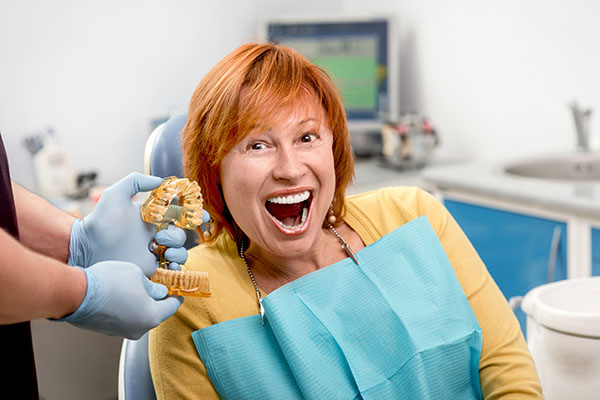All-on-4® Implants as a Dental Restoration Option

Dental implants have existed for decades as a popular dental restoration option. All-on-4® is a form of implant-supported dentures created to replace multiple missing teeth on a dental arch. So, what is All-on-4®, and how does it work as a dental restoration option? Continue reading to find out more.
Dental restoration: All-on-4® treatment
The All-on-4® option involves supporting a denture on four strategically placed dental implants. The implants are titanium metal posts that are placed inside the jawbone and function as the anchor for attaching the dental prostheses.
Placing implants can be an expensive undertaking. Minimizing the number of implants needed significantly reduces the cost and surgical sites needed for a predictable and long-lasting dental restoration. The all-on-4 option requires multiple dental appointments and healing time between treatment stages. Patients can expect the following during treatment:
Examination and records
During the consultation, the dentist will take x-rays of the remaining teeth to determine their condition. The dentist will use impressions of the upper and lower jaw to produce a precise model of the oral cavity. 3D images of the mouth may also be taken. These are used to check the jawbone’s thickness, location of the sinus cavity, nerves and other jaw structures. The dentist will discuss financing options, necessary arrangements and schedule a date for the surgery.
Developing the treatment plan
Before the surgery to place the implants, the dentist will review the patient’s records and develop a treatment plan from start to finish. The dentist will use the 3D images taken to develop a surgical guide. The guide allows them to place the implants strategically around the jaws and avoid the nerves and sinus cavities.
Surgical procedures
Before placing the implants, the dentist will remove the remaining teeth. Tooth extractions may be done on the day of implant placement or before. Sometimes, it may be necessary to extract the teeth and wait for the bone to heal. If the bone is too thin to hold implants, or sinus cavities will inhibit the procedure, the dentist may perform bone grafts or sinus lift procedures. These procedures usually require a healing period before placing the implant.
Implant placement
The dentist will sedate the patient for the procedure. The surgical guides will be used to create small holes inside the bones with high precision. Four points will be prepared on the jaw for the All-on-4 implants. The dentist will place titanium metal posts into the holes, and a healing cap will be placed over them to protect the implants. The implants need to integrate with the jawbone, and this may take between three to six months. During this time, the dentist will provide temporary dentures for dental functions.
Placing the restorations
After the healing phase, the implants are securely anchored inside the bone. The dentist will attach abutments to the implants to serve as the base for the permanent dental restoration, which is made in a dental lab. Once the denture is connected to the implants, they will function like natural teeth.
In conclusion
If you have missing teeth and would like to get All-on-4 as a dental restoration option, contact us to set up a consultation.
Request an appointment here: https://www.roderickgarciadmd.com or call Roderick A. Garcia, DMD PC at (505) 634-5029 for an appointment in our Albuquerque office.
Check out what others are saying about our services on Yelp: Read our Yelp reviews.
Recent Posts
Adjusting to new dentures can involve several changes to a person's routine. One thing that should stay the same, however, is regular dentist appointments. Here is what a new patient needs to know about the importance of dentist appointments and how often he or she needs to visit the dentist after receiving dentures.One commonly asked…
In addition to recognizing the new person in the mirror, adjusting to new dentures requires changing some of a person’s former eating habits. Having a full set of great-looking teeth can give one’s confidence a significant boost, but after spending a considerable amount of time without teeth, it can take a little while to learn…
When there is an aesthetic issue with one of your teeth, dental bonding may be an effective treatment option. Common problems addressed by bonding include broken teeth, severely discolored teeth, or teeth that are slightly off in shape or size. Since they are not as durable as other restorative treatments, bonding is usually used for…
Dental hygiene and fresh breath go hand in hand, and for many patients, a regular dental cleaning is a crucial part of their oral care routine to have healthy teeth and gums and avoid bad breath, or halitosis.In this article, we delve into dental cleaning and its relationship with bad breath. We explore how routine…


